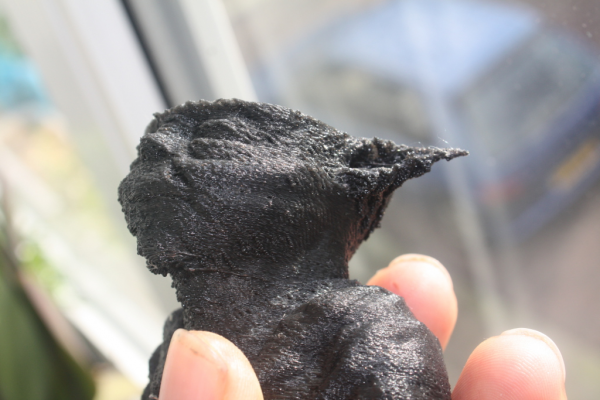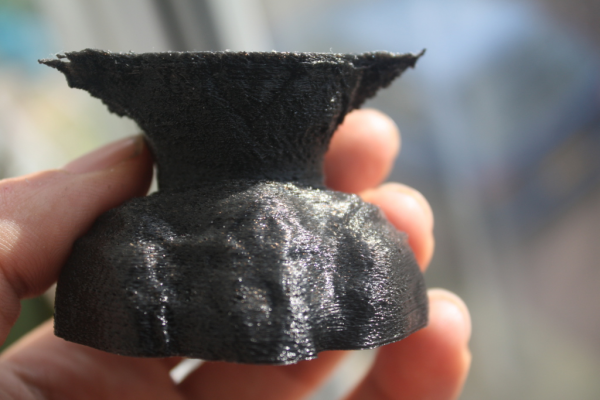curling mid print and overhangs
Posted by sam80
|
curling mid print and overhangs March 13, 2013 06:06AM |
Registered: 11 years ago Posts: 22 |
I'm having some major issues with regards to curling and sagging.
any possible solution and theories are welcome. I don't have a cooling fan pointed towards it.
specs;
running on QU-BD exgtruder,
0.35mm nozzle
black PLA
190 degrees
heated bed
the printed yoda head was at 100mm/s infill and 50mm/s perimeter. 50% infill.
thanks for your help
any possible solution and theories are welcome. I don't have a cooling fan pointed towards it.
specs;
running on QU-BD exgtruder,
0.35mm nozzle
black PLA
190 degrees
heated bed
the printed yoda head was at 100mm/s infill and 50mm/s perimeter. 50% infill.
thanks for your help

|
Re: curling mid print and overhangs March 13, 2013 08:06AM |
Registered: 11 years ago Posts: 251 |
Have a cooling fan then!  Apart from reducing curling, it's good for your hotend if your printing pla or else you are liable to get a jam.
Apart from reducing curling, it's good for your hotend if your printing pla or else you are liable to get a jam.
However you seem to have other quality issues to sort out first before tackling the curling. Slow your printer right down to say 30mm/s for now and lower your acceleration/jerk loads. Make sure your belts are tight and ensure your hotend has zero wobble when hot. Make sure there are no loose fixings on your printer allowing excessive vibration.
Confirm your e-calibration is bang on.
 Apart from reducing curling, it's good for your hotend if your printing pla or else you are liable to get a jam.
Apart from reducing curling, it's good for your hotend if your printing pla or else you are liable to get a jam.However you seem to have other quality issues to sort out first before tackling the curling. Slow your printer right down to say 30mm/s for now and lower your acceleration/jerk loads. Make sure your belts are tight and ensure your hotend has zero wobble when hot. Make sure there are no loose fixings on your printer allowing excessive vibration.
Confirm your e-calibration is bang on.
|
Re: curling mid print and overhangs March 13, 2013 08:47AM |
Registered: 11 years ago Posts: 79 |
You really need a fan to improve the PLA prints. Not sure which slicer you are using but make sure cooling is turned on. Also may want to reduce the temp slightly. You did not give the specs on the heatbed, but 60 degrees and PVA works well.
Also above only works if calibration is correct. Need to verify e-steps and also double check all the axis.
Z starting height is also important. If your first layer is not going down clean and flat then you may be too low or high.
Also above only works if calibration is correct. Need to verify e-steps and also double check all the axis.
Z starting height is also important. If your first layer is not going down clean and flat then you may be too low or high.
|
Re: curling mid print and overhangs March 13, 2013 09:58AM |
Registered: 11 years ago Posts: 22 |
Quote
However you seem to have other quality issues to sort out first before tackling the curling. Slow your printer right down to say 30mm/s for now and lower your acceleration/jerk loads. Make sure your belts are tight and ensure your hotend has zero wobble when hot. Make sure there are no loose fixings on your printer allowing excessive vibration. Confirm your e-calibration is bang on.
Thanks, I will check all of these and come with some feedback on it.
Quote
You really need a fan to improve the PLA prints. Not sure which slicer you are using but make sure cooling is turned on. Also may want to reduce the temp slightly. You did not give the specs on the heatbed, but 60 degrees and PVA works well.
I've set it at 65 degrees with kapton tape on a aluminium bed heated with rubber heater. I use latest Slic3r. i will print a fan for it tonight and will go through the following checklist;
- check E-steps
- check wobble when extruder is hot (altough it's bolted by M6 and threadlock fluid applied on it)
- Check belt tightness (it's now like guitar string)
- check vibration
- check XYZ steps per mm.
- put a fan
- print at 20/30 mm/s speeds to check difference
- slower accelerations loads/jerks.
any suggestion on a sample model to test this? doing another yoda takes quite a long time
 . Because I want to trial and error on each item on the list to give a feedback on what the problem was with my case, which might be of use to others.
. Because I want to trial and error on each item on the list to give a feedback on what the problem was with my case, which might be of use to others.my axis settings in marlin;
-----------------------------------------------------------------------------------------
#define DEFAULT_AXIS_STEPS_PER_UNIT {80,80,2560,93.36304} // default steps per unit for ultimaker
#define DEFAULT_MAX_FEEDRATE {500, 500, 5, 45} // (mm/sec)
#define DEFAULT_MAX_ACCELERATION {4500,4500,100,10000} // X, Y, Z, E maximum start speed for accelerated moves. E default values are good for skeinforge 40+, for older versions raise them a lot.
#define DEFAULT_ACCELERATION 1500 // X, Y, Z and E max acceleration in mm/s^2 for printing moves
#define DEFAULT_RETRACT_ACCELERATION 1500 // X, Y, Z and E max acceleration in mm/s^2 for r retracts
//
#define DEFAULT_XYJERK 10.0 // (mm/sec)
#define DEFAULT_ZJERK 0.4 // (mm/sec)
#define DEFAULT_EJERK 5.0 // (mm/sec)
-----------------------------------------------------------------------------------------
I use T2.5 belt and 16teeth pulley, and QU-BD extruder as mentioned.
Edited 2 time(s). Last edit at 03/13/2013 10:40AM by sam80.
|
Re: curling mid print and overhangs March 13, 2013 11:52AM |
Registered: 11 years ago Posts: 79 |
Start out testing with the 20mm cube hollow with one perimiter.
If this prints true and straight then yoda should print much nicer.
One note on Z wobble at the hot end.
Manually run your z axis up and down, watch the hotend tip. If you have Z wobble the hotend will be moving at the tip and your X slide will be twisting as it is moving up and down.
What type of printer are you using, this will help to diagnose z wobble.
If this prints true and straight then yoda should print much nicer.
One note on Z wobble at the hot end.
Manually run your z axis up and down, watch the hotend tip. If you have Z wobble the hotend will be moving at the tip and your X slide will be twisting as it is moving up and down.
What type of printer are you using, this will help to diagnose z wobble.
|
Re: curling mid print and overhangs March 15, 2013 01:41PM |
Registered: 11 years ago Posts: 22 |
Right, back with some updates.
my checklist;
- check E-steps (were correct)
- check wobble when extruder is hot (altough it's bolted by M6 and threadlock fluid applied on it) (were correct)
- Check belt tightness (it's now like guitar string) (were correct)
- check vibration (were correct)
- check XYZ steps per mm. (were correct)
- put a fan (still not done)
- print at 20/30 mm/s speeds to check difference (major improvement in quality)
- slower accelerations loads/jerks. no significant difference
right, after trial and errors, it seems by printing the perimeters at lower speeds and just the infill at hihger speeds I get some better results. Altough this might bring forth the next theory...
- when I print a full cube with 100% infill, at high perimeter speeds (100mm/s) then there is no jitter, drooling unlike in the yoda picture in my earlier post.
- when I print the Yoda with 100% infill at high perimeter speeds(80mm/s), then you get terrible jitter, drooling etc.
Can I savely assume that the curling and drooling etc are cause by the fact at the higher speeds the perimeter does not cool fast enough.. hence the needed fan.
I don't think the picture does it just, it looks quite awesome.
my checklist;
- check E-steps (were correct)
- check wobble when extruder is hot (altough it's bolted by M6 and threadlock fluid applied on it) (were correct)
- Check belt tightness (it's now like guitar string) (were correct)
- check vibration (were correct)
- check XYZ steps per mm. (were correct)
- put a fan (still not done)
- print at 20/30 mm/s speeds to check difference (major improvement in quality)
- slower accelerations loads/jerks. no significant difference
right, after trial and errors, it seems by printing the perimeters at lower speeds and just the infill at hihger speeds I get some better results. Altough this might bring forth the next theory...
- when I print a full cube with 100% infill, at high perimeter speeds (100mm/s) then there is no jitter, drooling unlike in the yoda picture in my earlier post.
- when I print the Yoda with 100% infill at high perimeter speeds(80mm/s), then you get terrible jitter, drooling etc.
Can I savely assume that the curling and drooling etc are cause by the fact at the higher speeds the perimeter does not cool fast enough.. hence the needed fan.
I don't think the picture does it just, it looks quite awesome.
|
Re: curling mid print and overhangs March 19, 2013 11:26AM |
Registered: 11 years ago Posts: 251 |
>
> Can I savely assume that the curling and drooling
> etc are cause by the fact at the higher speeds the
> perimeter does not cool fast enough.. hence the
> needed fan.
>
First off, that's looking quite decent now!
But yes this is a possibility, make sure your slicer has an appropriate "minimum layer time". This might need to be as high as 30 seconds without a fan.
Secondly print a cube at 1 perimeter, zero infill, having explicitly defined the extrusion width in your slicer (extrusion with 20% wider than nozzle works well for me) when it's gotten to a decent height, measure the width of the single wall - it should match your setting. If not
, adjust your flow rate accordingly. This can need adjusting even if your E steps are bang on.
> Can I savely assume that the curling and drooling
> etc are cause by the fact at the higher speeds the
> perimeter does not cool fast enough.. hence the
> needed fan.
>
First off, that's looking quite decent now!
But yes this is a possibility, make sure your slicer has an appropriate "minimum layer time". This might need to be as high as 30 seconds without a fan.
Secondly print a cube at 1 perimeter, zero infill, having explicitly defined the extrusion width in your slicer (extrusion with 20% wider than nozzle works well for me) when it's gotten to a decent height, measure the width of the single wall - it should match your setting. If not
, adjust your flow rate accordingly. This can need adjusting even if your E steps are bang on.
Sorry, only registered users may post in this forum.

